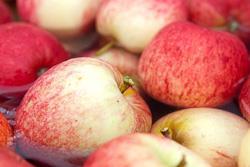
The bell rang for the penultimate round in the long-running dispute between Australia and New Zealand over apple imports last night, with the World Trade Organisation (WTO) deciding in favour of New Zealand.
In essence,the WTO rulingestablished that the Australian quarantine restrictions imposed in 2006 on New Zealand apple imports were not based on science, effectively clearing the way for access in either 2011 or 2012, according to industry figures.
“There were two overarching findings,” Pipfruit New Zealand CEO Peter Beaven told Fruitnet.com.
“The first was that under `international law` you are required to do a science-based import risk analysis (IRA). The WTO found that the `Australian` risk analysis was not based on sound science. In many parts they found Australia had greatly exaggerated the risk.
“They also found that `Australia` had an obligation under law to use the least restrictive measures available under the protocol they required. The WTO found those measures `in the IRA` were more trade restrictive than were required by the science.”
The ruling is a blow for Australian apple growers, who have previous said New Zealand access could cost the industry upwards of A$30m (US$27.5m). New Zealand growers have estimated the value of the Australian market at NZ$30-100m (US$22-73m).
While peak body Apple & Pear Australia Ltd (APAL) has described the ruling as “not ideal”, the industry is not in a state of panic, according to John Corboy, chairman of APAL’s fireblight taskforce.
Appeal on the cards
Australia’s agriculture minister Tony Burke told local media this morning the federal government would appeal the decision with the WTO.
“`The appeal` takes the sting out of it,” Mr Corboy told Fruitnet.com. “It doesn’t make it a good outcome, but it puts a hold on it. `The reaction in the industry` is not one of panic.”
While that appeal process is expected to postpone a final ruling until the end of the year, industry figures on both sides of the issue told Fruitnet.com that the appeal was unlikely to yield a different result.
“There have been quite a number of appeals to the WTO and not one of them has been upheld yet,” explained Pipfruit New Zealand chairman Ian Palmer.
Protocol possibilities
If the ruling is upheld, a technical work-plan for access will then need to be negotiated between the two countries. While forecasts are difficult to make at this early stage, recommendations in the WTO ruling suggest the resulting access protocol could be quite straightforward for New Zealand apple exporters.
UnderBiosecurity Australia’s 2006 IRA, New Zealand exporters were required to perform 3,000-unit inspections for apple leaf-curling midge (ALCM) per export lot, along with two orchard inspections and chlorine treatment for fireblight and European canker, among other requirements.
“In relation to fireblight and European canker, the WTO ruling found that the only requirement needed to protect Australia was that the fruit was mature and symptomless,” said Mr Beaven. “In the case of ALCM, a 600-fruit inspection `was found to be` sufficient, which is already the standard sampling regime in New Zealand.”
Mr Beaven said he hadn’t expected the WTO panel to make such suggestions, but that they were likely to form the basis of any eventual protocol.
Market impact
The impact of New Zealand apples on the Australian market will depend largely on the final form that protocol takes, according to Alastair Scott of Hannay Douglas, which exports fresh produce from both Australia and New Zealand.
“It’s really going to depend on how workable the protocol is and how difficult it is to adhere to, regarding how many people will take it up,” he told Fruitnet.com.
New Zealand is expected to focus on apple varieties that don’t make up a large portion of Australian domestic production; Pacific Rose, Braeburn, Jazz and Envy.
“We’ve got different varieties, complementary varieties, and we want to grow the market, not thrash it,” states Mr Beaven. “We’re pretty keen to work with the Australian industry, and we think we can do that. The two industries have a lot more in common than there are differences to keep us apart.
“We have always taken the view that we don’t want to pinch the Australian market off Australian growers. Our position is to grow the market.”
But despite that standpoint, there is no doubt that the Australian market dynamic will change with the introduction of New Zealand apples, according to Mr Corboy.
“But my belief is that it would be short-term change. The Australian fruit market is not the panacea that some people think it is. There’ll be a period of change and then people will get on with it; we’ve seen the stonefruit industry do it, we’ve seen it happen with Chinese pears. People adjust.”
The Australian apple industry is also enjoying the support of the country’s two major supermarket chains, Coles and Woolworths. The two have committed to not handling imported apples, said Mr Corboy, who described the retailers’ positions as “heartening”.
Consumption figures
Per capita consumption of apples in Australia is relatively low for a Western nation, sitting at 6-10kg annually, compared to New Zealand’s 15kg and Germany’s 18-20kg.
Mr Beaven explained one of New Zealand’s goals would be to increase Australian consumption, although the specific methods to achieve that goal are uncertain.
There were few low-hanging fruit in that respect, said Mr Corboy.
“My response is that Australians don’t eat enough apples and pears, and anything to improve that is good,” he said. “But we don’t know what New Zealand can do. The statement is easy to make, but we’d be interested to see what their delivery is.”



